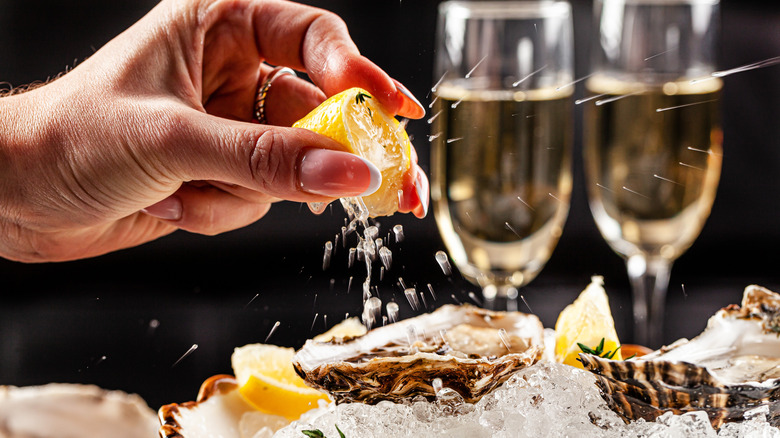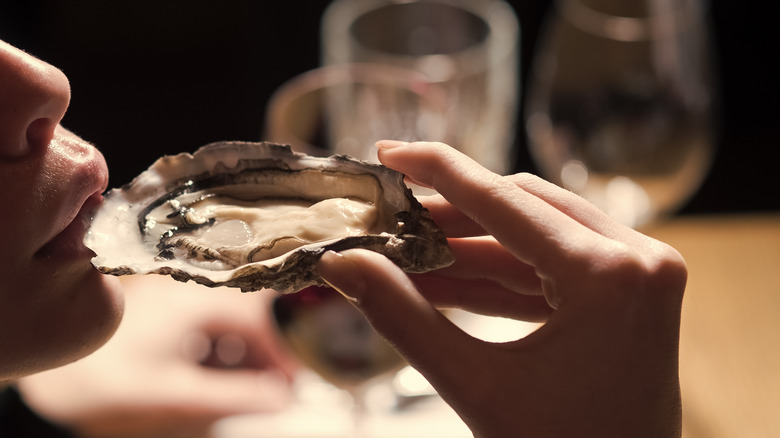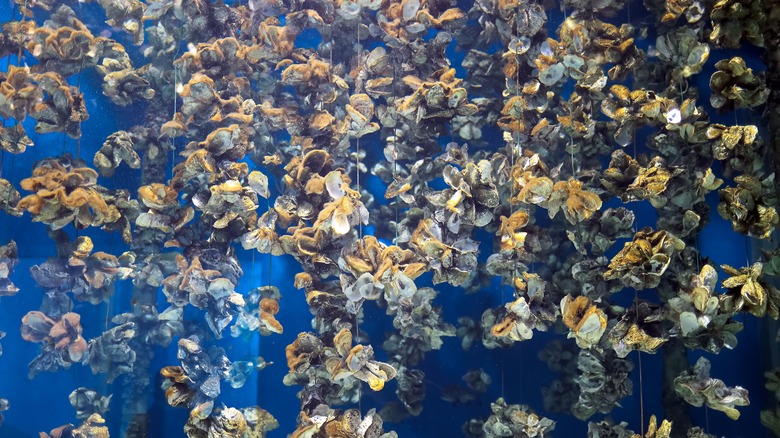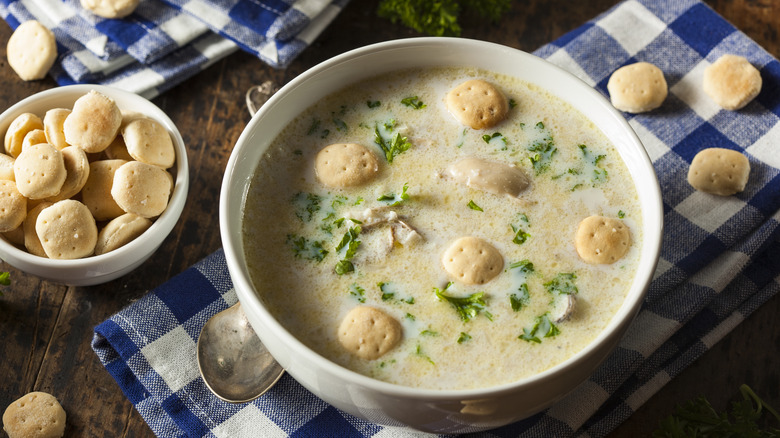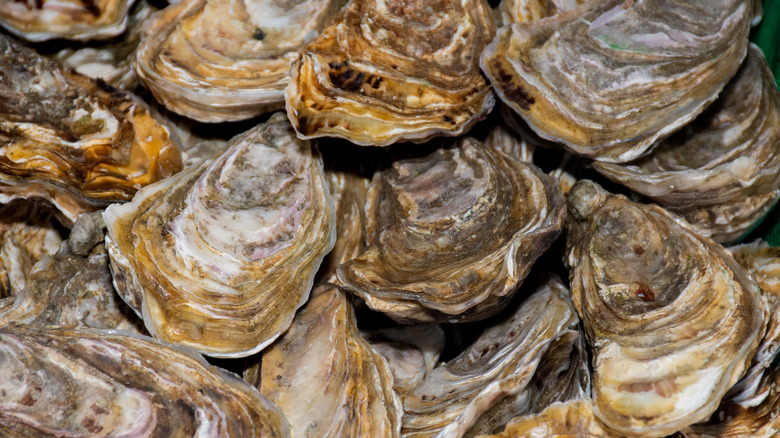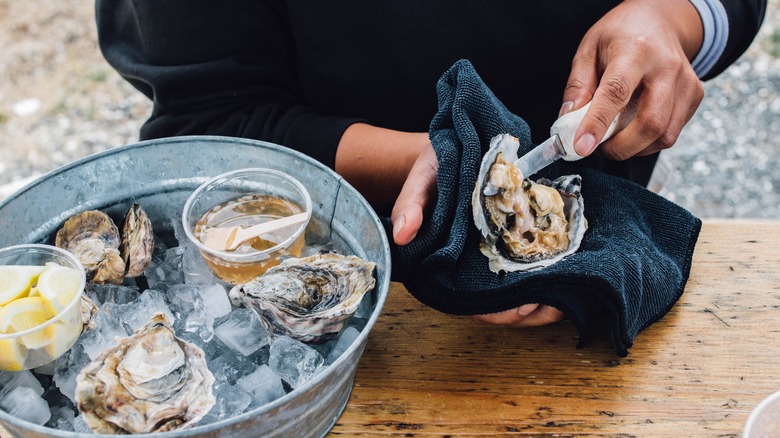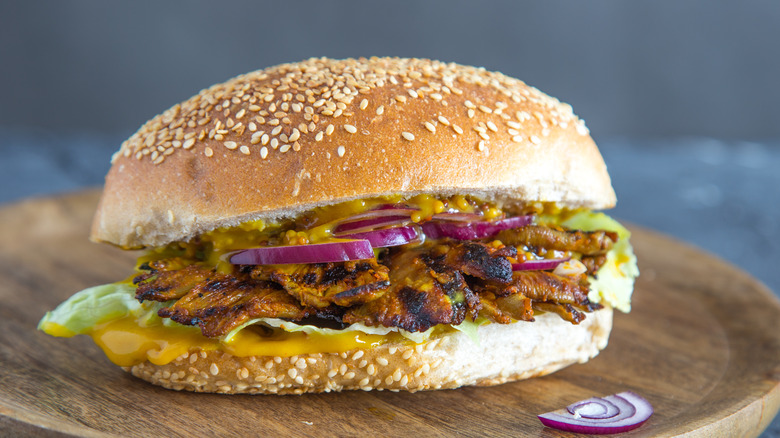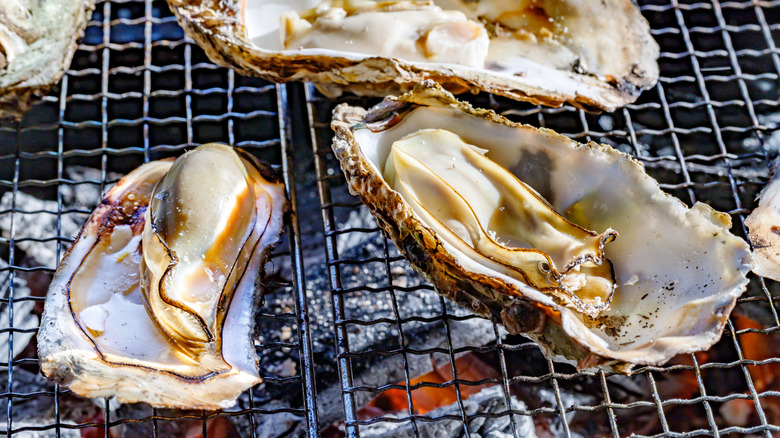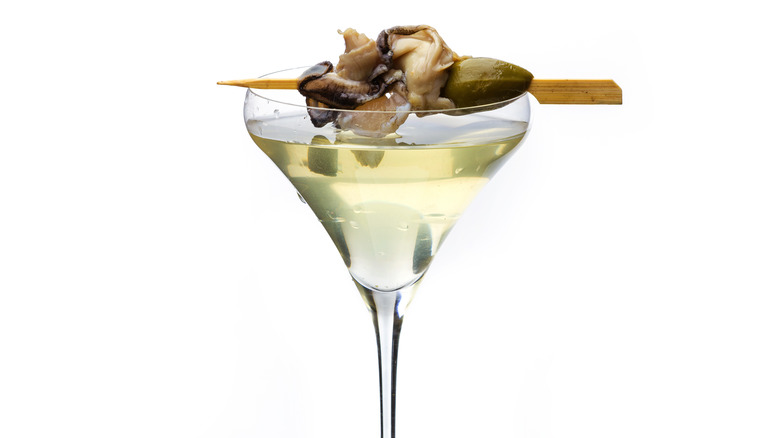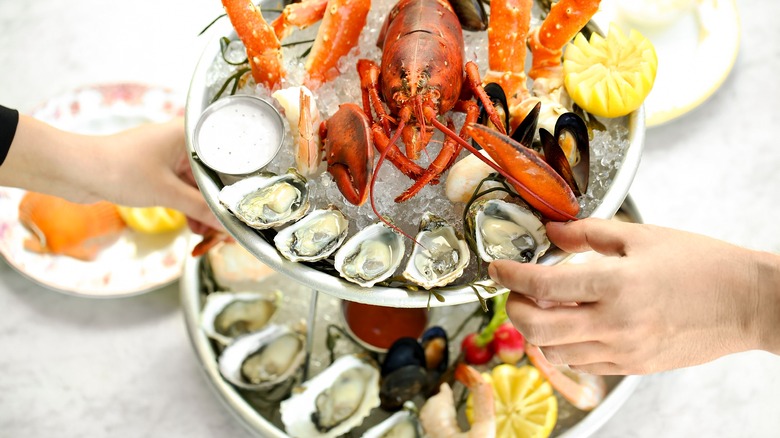Common Mistakes Everyone Makes With Oysters
If you fancy yourself a modern-day Lothario, you probably eat a lot of oysters because of their reputation as an aphrodisiac. However, the love police over at the Pharmacognosy Review journal has made it pretty clear that there is no scientific evidence to back the claim that oysters are an aphrodisiac.
This is just one common mistake everyone makes when it comes to oysters. To be fair, you probably aren't preparing and eating oysters every day. Mistakes will be made, but they should be avoided — given the eye-watering prices associated with these tasty mollusks. It's hard to believe that oysters were once a cheap, accessible street food. But as the popularity of oysters grew during the late 19th and early 20th centuries, overfishing drove up prices. And thanks to 20th-century crackdowns on — ahem — child labor, it's hard to get 4-year-olds to shuck oysters on the cheap these days (via Business Insider).
Yes, oysters are expensive, and so every mistake gets multiplied by the dollars and cents you spend on them. With this in mind, let's go over some common oyster mistakes and how they can be avoided.
Eating raw oysters with an underlying health condition
We've all heard that it's risky to eat raw oysters, but is that actually true? Or just an urban legend that moms tell their kids before they go on spring break? Well, the CDC has issued guidance on eating raw oysters: Raw oysters are not safe to eat... but you could probably eat them and be okay.
Raw or undercooked oysters can harbor a pathogen known as Vibrio bacteria, which causes a sickness called vibriosis. The CDC calls a typical vibriosis infection "mild," if you consider diarrhea and vomiting to be mild. A severe infection could lead to death. You are at higher risk to get a serious case of vibriosis if you already have a major health condition like cancer, HIV, diabetes, or liver disease. You are also at higher risk if you take immunosuppressant drugs or recently had stomach surgery. People over the age of 65 are also at higher risk of contracting the disease.
If you don't want any chance of getting vibriosis, you should only eat fully cooked oysters — which are still pretty tasty. The CDC says boiling, frying, or broiling oysters at high heat for at least three minutes should kill any Vibrio bacteria. You could also bake oysters at 450 F for 10 minutes.
Not chewing your raw oyster
It seems a bit ridiculous to tell you to chew your food like you're a 5-year-old itching to get away from the dinner table. But you should chew your oysters, according to master shucker and Vice contributor Eddie "Oysters" Casiano. The last thing you want to do when eating oysters is to down a bad one, and Casiano says chewing an oyster can help you suss out a foul-tasting bad oyster before you swallow it. Whether you discreetly spit out a bad oyster into your napkin or hock it across the room like a Looney Toons cowboy is entirely up to you. Chewing an oyster also helps to release more flavor so you can pick up on more subtleties.
Casiano also recommends going light on any sauce for raw oysters. A few drops of freshly squeezed lemon juice, maybe a drop of hot sauce, can make a raw oyster taste more well-rounded. The expert notes that lemon juice is capable of killing bacteria, which is not a bad thing when eating raw seafood. However, you probably shouldn't count on it being a total disinfectant. Casiano also says you shouldn't put any cocktail sauce or other strong toppings on premium oysters, as they can totally overpower any delicate flavors that make premium oysters so pricey.
Dismissing farmed oysters in favor of wild-caught
If you are an all-natural, whole-food, locavore true believer, you probably think the difference between farmed and wild oysters is that the former is far inferior to the latter. The truth, though, is hardly that straightforward. First, let's dispel the idea that human intervention in the food chain is always a bad thing. According to a 2007 story from The New York Times, aquaculture oysters bred to be disease-resistant sparked a resurgence of wild oysters in Atlantic Coast waters stretching from Connecticut to New Jersey.
Likewise, the same American aquaculture that led to a resurgence of coastal oysters also gave rise to farmed oysters that are more convenient, and possibly more sustainable. Farmed oysters take just two years to reach harvesting size, while wild oysters take about three years, meaning they take longer to replace. Oyster farms also remove pollution from waterways, allowing sunlight to penetrate deeper into the ocean and promote the growth of seagrass, an essential pillar of marine ecosystems. On top of that, wild oysters lose their rich flavor in summer, when they reproduce, while farmed oysters are sterile and don't have this issue.
Not drinking or cooking with the oyster liquor
We're going to put this one down as being a newbie mistake, but you should never pour out the small amount of briny water that comes in each oyster shell. Known as "oyster liquor," the liquid inside an oyster is tasty and it's often used to add flavor to dishes like oyster dressing and oyster stew.
You may not associate oysters with Thanksgiving, but the oyster dressing is a holiday tradition in many areas of the United States and the Gulf Coast in particular. The typical oyster dressing recipe is made with cornbread and flavored with thyme, bay leaves, and sage. It's important to only cook the oysters for three minutes, to keep them from getting dry and rubbery. Adding in the liquor amps up the oyster flavor and allows it to permeate into the entire bread dish.
Brought to the United States by Irish immigrants, oyster stew is a Christmas Eve tradition. In addition to being the kind of luxury you treat yourself to around the holidays, the tradition of eating oyster stew on Christmas Eve also probably came from the old adage that you should only eat oysters in months that end in "r"— like November and December. Adding in oyster liquor means you get to taste oysters in both the broth and the oysters themselves.
Storing oysters in tap water
Oysters aren't cheap, and it's your job to keep them as fresh as possible until it's time to eat. First, it's important to start with fresh oysters that are still alive. Before you buy them, check to make sure each oyster is tightly closed and does not have any noticeable cracks, chips, or blemishes. Also, check to make sure they don't have a pungent odor, which is a sign they've gone bad. If you are buying shucked oysters, make sure they do not have a brownish color or the liquid they're in doesn't appear cloudy.
After buying them and bringing them home, the best way to keep oysters fresh is to keep them cold and damp. Never store live oysters in freshwater from your tab because chlorine and other municipal water treatments can kill them. Experts recommend storing fresh oysters on a tray, covered with a damp cloth, and in the coldest part of your refrigerator, ideally between 38 F and 45 F. Oysters should also be stored with the rounded side down because this causes the oyster to rest and its briny liquor, which helps to keep it alive.
If you aren't eating them right away, it's a good idea to check your oysters once in a while. If you see that one has opened, this is normal. Giving it a gentle knock should cause it to close. If the oyster doesn't close, it's probably gone bad and should be thrown away.
Using bad shucking techniques
When it comes to preparing your own oysters, there's no bigger challenge than shucking. Oyster shucking is an art form that you need to appreciate and try to master if you're doing it yourself. If you don't know how to shuck an oyster, don't worry, we got you.
The most dependable way to shuck an oyster is to use a handheld grip technique, which requires a kitchen towel and an oyster knife. Start by triple folding the towel and placing it in the palm of your non-dominant hand. Place the oyster flat-side-up in the middle of the towel with the curved "front" edge facing your fingertips. Tightly grip the oyster. Push and wiggle the tip of the knife as you try to insert it between the shell lips at one end of the curved edge. Once the knife slips between the lips, insert it halfway and push down to leverage open the shell. Once the shell opens slightly, remove the knife and clean the tip. Rotate the shell 45 degrees, reinsert the knife tip at the middle of the curved edge, and work to fully pry off the shell. Remove any bits of the shell.
Asking for an oyster fork at a fancy restaurant
When you get oysters on the half-shell — whether they're raw or cooked — they should be fully separated from the shell. It's the most basic part of the preparation. If the oyster is still attached to the shell, it's a culinary no-no skin to getting a big pit on top of your avocado toast.
If you want to separate the oyster, you could ask for an oyster fork, but if you do, you'd better need it. When you ask for an oyster fork at a fancy restaurant, you are essentially telling the chef and their staff that they did not do their job. That's a pretty big insult and one you may want to avoid, even if you feel totally justified. Instead, use your knife to loosen the oyster.
Speaking of oyster etiquette, the proper way to eat raw oysters on the half shell is to bring the shell to your bottom lip, tilt the show slightly, and allow the oyster to slip into your open mouth. Once you have (chewed and) eaten the oyster, the proper thing to do this place the shell face down on the plate. If you are sharing a plate of oysters, it lets the other people at your table quickly see how many oysters are left. Once you have finished all the raw oysters, a plateful of downturned shells lets the waitstaff know you have finished the dish.
Not considering the many different preparations
In the same way you don't want to pour some Pappy Van Winkle 20 Year into a tall glass of Coke, you do not want to cover up the flavors of premium oysters with other, cheaper flavors. But if you're going to be eating garden-variety, workingman's bivalves, there are plenty of sensible preparations to consider and a lot of oyster bars are getting pretty creative these days. We suggest channeling your inner Top Chef and taking inspiration from some unique preparations at the country's top oyster bars.
One of the more creative oyster bars in the country is The Ordinary in Charleston, South Carolina. At the restaurant, chef and owner Mike Lata turns the fried oyster po'boy on its head with his crispy oyster slider, topped with banh mi-style coleslaw and served on a house-baked Hawaiian roll. The Ordinary also serves raw oysters with a house-made lemongrass cocktail sauce. Other eye-catching preparations from around the country include baked, truffled oysters from Grand Army in Brooklyn and the deviled oysters at Connie and Ted's in Los Angeles.
Overcooking them on the grill
Grilled oysters probably taste best on a hot summer day, but there's nothing wrong with throwing some oysters on the grill in cold weather. Cooking oysters on a backyard grill does require a bit of planning and finesse if you want to get the best out of this premium product.
When giving advice to us on how to grill oysters, chef Ethan Powell said it's important to select oysters from the West Coast because they tend to be plumper and creamier. He also said it's important to work quickly when grilling oysters. After oysters are placed on a hot grill, they pop open quickly. As soon as they do, you should remove them from the heat, being careful not to spill any briny liquor from inside the shell. Powell then recommends adding a bit of lemon-butter sauce to the oyster and placing it back on the heat just until you see the sauce start to bubble. If lemon butter sauce isn't your thing, Powell said any compound butter should do the trick.
Not getting the right beverage pairing
When it comes to beverage pairings, oysters can be pretty versatile, but some pairings work better than others. The salty, slightly sweet flavors of oysters work famously with the fruity, mineral qualities of Champagne. Muscadet and oysters is a lesser-known wine pairing that works thanks to that wine's clean, bright qualities.
But you don't just have to stick to wine when trying to decide what to drink with oysters. Some lagers work really well with the mollusks, and we suggest pairing a good lager with Northern Cross oysters from Virginia. Smoky, fruity mezcal is another good pairing partner, and we recommend pairing it with Olympia oysters from Washington state.
Oysters also go very well with gin martinis. According to our definitive guide to using oysters and martinis, salty citrusy notes in the classic cocktail are ideal partners for the sweet briny qualities of oysters. So what is the best way to combine oysters and a martini? The easiest way is simply to plop an oyster in the bottom of your martini glass. Doing this allows the bivalve to absorb some of the martinis, making it plumper. If you would like even more oyster flavor in your cocktail, you could also infuse vermouth with oysters before using it in a martini. If you enjoy making modern cocktails, you could whip oyster liquor with egg whites and a bit of lemon to create a foam garnish that can be laid on top of your cocktail.
Making guests work at your seafood raw bar
Setting up a home raw bar is a real power move. It's basically the king of house party offerings, and if we have learned anything from The Wire, it's: If you come at the king, you best not miss. Lucky for you, we have an essential primer on how to make a raw bar at home that'll rule the roost.
Of course, this is an article on oysters, and they should be the star of your raw bar show. Do not shuck your raw bar oysters until the last minute. This is because oysters are alive until you shuck them. If you've got a lot of oysters on your hands, pick up an extra oyster knife or two and recruit some capable party guests right after they arrive. Treat it like a fun party game, and make sure no one slices their hand open.
A key part of a successful raw bar is making it as easy as possible for your guests to enjoy. Make sure your oysters and other shellfish are clean, free of shell bits, and ready to eat. Place all of your shucked oysters and other shellfish and plenty of crushed ice. Set out some sauces, lemon wedges, small forks, little spoons, and moist towelettes before allowing your guests to dig in. A pro move is also offering guests champagne or other beverages that pair well with raw shellfish.
